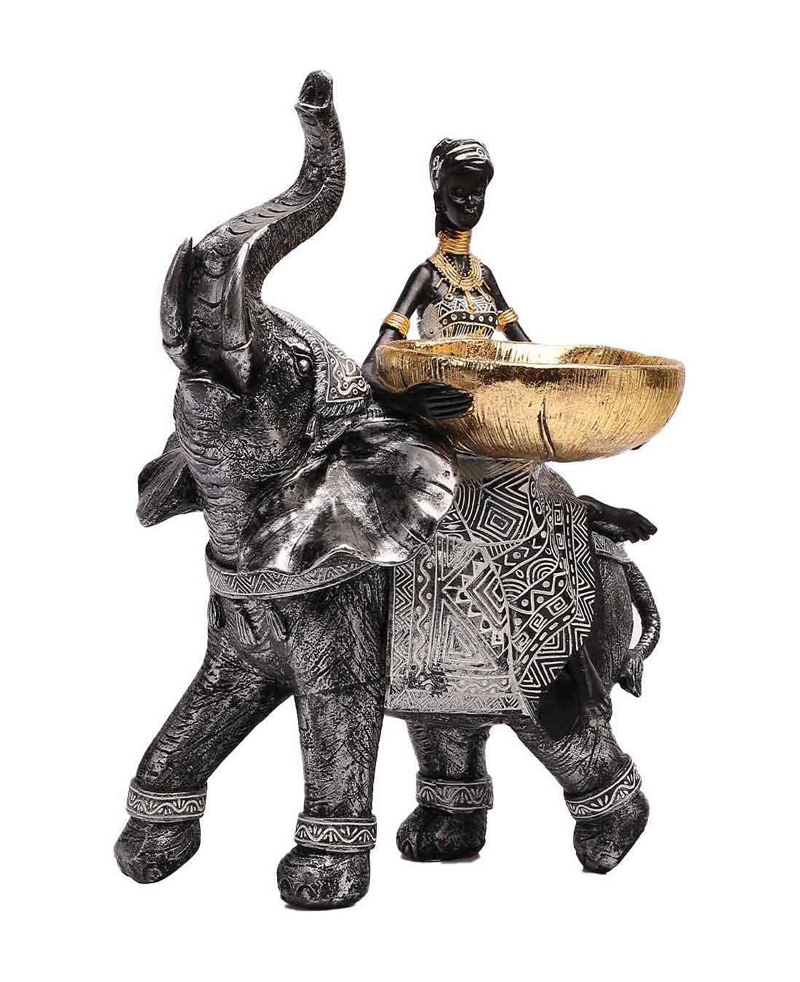African Elephant and African Tribal Lady Totem Statue
This African Elephant Totem Statue express the African cultural aspects of spirituality, a combination of symbolism expressing a rich African cultural belief and appreciation of Nature and the Human Spirit. The Tribal Lady embraces the offering bowl ,which can hold small objects, such as rings, necklaces, keys and watches and so on. The offering bowl symbolizes personal gratitude to nature for providing a prosperity of needs. The body gesture of the tribal lady statues expresses a sign of welcome and respect to friends and families. The African Elephant is not only representing the strength and power in the human spirit. It also symbolizes the aspect of endurance, maturity, longevity, and loyalty. The African Elephant (Loxodonta) is a genus comprising 2 living elephant species, the African Bush Elephant (L. Africana) and the smaller African Forest Elephant (L. Cyclotis). Both are social herbivores with grey skin, but differ in the size and colour of their tusks and in the shape and size of their ears and skulls. Both species are considered at heavy risk of extinction on the IUCN Red List, as of 2021, the bush elephant is considered endangered and the forest elephant is considered critically endangered.
They are threatened by habitat loss and fragmentation, and poaching for the illegal ivory trade is a threat in several range countries as well. Loxodonta is 1 of 2 extant genera of the family Elephantidae. The name refers to the lozenge-shaped enamel of their molar teeth. Fossil remains of Loxodonta species have been excavated in Africa, dating to the Middle Pliocene. Many Totemic Tribes believe that after death, everyone turns into an animal of his totem, and therefore, every animal, a deceased relative. When they saw the murder of his totem, saying: “Why have killed this man? It’s my father, my brother?” in places where there is division in sex totems, representatives of women find their totem her sisters, men, brothers. Totemism, is another ancient form of traditional African religions. Totem, a type of animal or plant which is symbolic saint patron, and at a later stage, the ancestor of a group of blood relatives. Totems represented the relationship between man and wildlife. The concept of using totems demonstrated the close relationship between humans, animals and the lived environment.
Anthropologists believe that Totem use was a universal phenomenon among early societies. Pre-industrial communities had some form of totem that was associated with spirits, religion and success of community members. Early documented forms of Totems in Europe can be traced to the Roman Empire, where symbols were used as coats of arms, a practice which continues today. In Africa, chiefs decorated their stools and other court items with their personal totems, or with those of the tribe or of the clans making up the larger community. It was a duty of each community member to protect and defend the totem. This obligation ranged from not harming that animal or plant, to actively feeding, rescuing or caring for it as needed. African tales are told of how men became heroes for rescuing their totems. This has continued in some African societies, where totems are treasured and preserved for the community’s good. Totems have also been described as a traditional environmental conservation method besides being for kinship. Totemism can lead to environmental protection due to some tribes having multiple totems.
For example, over 100 plant and animal species are considered totems among the Batooro, Banyoro and Baganda tribes in Uganda, a similar number of species are considered totems among tribes in Congo and the Central African Republic. In Zimbabwe, totems have been in use among the Shona groupings since the initial development of their culture. Totems identify the different clans among the Shona that historically made up the dynasties of their ancient civilization. Today, up to 25 different totems can be identified among the Shona ethnic grouping, and similar totems exist among other South African groups, such as the Zulu, the Ndebele, and the Herero in Botswana and Namibia. Those who share the same totem regard each other as being related even though they are not blood relatives and will find difficulty in finding approval to marry. Through Totem use one can practically establish some form of kinship with anyone else in the region. Establishing relationships this way made it easier for a traveller or stranger to find social support. Totems are also essential to cast a curse. African Elephant and African Tribal Lady Totem Statue sizes: 8.3 inches / 21 cm x 5.6 inches / 14 cm x 11.4 inches / 29 cm.
African Elephant Totem Statue on Amazon.
African Elephant Totem Statue on eBay.
Animals Statues, Elephants Statues, African Statues and Totem Statues.



